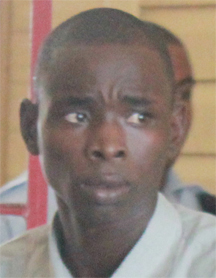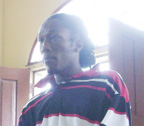The state and defence yesterday made their final arguments to the jury in the Lusignan massacre trial.
Justice Navindra Singh, who has been presiding over the trial in the High Court, will sum up the evidence in the case tomorrow, after which the matter will be handed over to the jury for deliberation and a verdict.
James Anthony Hyles, called ‘Sally,’ and Mark Royden Williams, called ‘Smallie,’

are the two men accused of the 11 murders.
Attorney Nigel Hughes, who represented Hyles, addressed members of the jury first, after which Senior State Counsel Judith Gildharie-Mursalin made her arguments.

Hughes told the court that the case is an awful one, in which the widows of the deceased suffered a brutal reality and that nothing can replace the loss they have suffered as a result.
He also said that when one comes from an office as powerful like the Director of Public Prosecutions (DPP), people are more likely to believe them so that is why the law requires them to bring evidence. Hughes went on to question why the prosecution did not bring its witness Durwin Wright to testify that Hyles used to hang out with the ‘Fineman’ gang, since he said that he knew Rondel ‘Fineman’ Rawlins.
He also told the jury that Wright confessed to the killing of Kumar Singh also known as ‘Mango Man’ and that when one looked at Wright’s evidence, there was nothing to suggest that he and Hyles had a friendship as they never hanged together, did not go to school together or talk politics with each other.
Despite this, Hughes referred to Wright’s evidence in which he said that Hyles went to his home on the morning after the massacre and told him he was part of the killings. Hughes asked, “Who in their right mind would pick somebody house and go and confess to a mass murder?”
The lawyer also stated that the prosecution did not present any evidence to say how Hyles was arrested. According to Hughes, after the Lusignan massacre, police used to go through Buxton and pick up a number of persons. He said that his client was picked up in this process and there was no evidence to suggest on what bases he was arrested.
In relation to former co-accused Dwane Williams’ evidence, Hughes said that he confessed to the killings of over 30 persons and yet he is now a free man. He told the court that he does not know how Williams could have stood up and watched the relatives of the deceased and not spend a day in jail.
Hughes also described Williams as a “self confessed murderer” who showed no remorse and who has purchased his freedom by implicating the two accused in the killings.
‘Mouth open, story
jump out’
But Gildharie-Mursalin rebutted what Hughes said, telling the jury that he had manufactured evidence that was never heard in the trial. She stated that the trial was made into a circus by the defence but yet the prosecution is accused of making it “into a cowboy trial.”
She encouraged jurors to use their common sense, while adding that there is no mistake in the case. She said that because ‘Fineman’ was angered that his girlfriend Tenisha Morgan was missing, he went and slaughtered 11 persons.
Part of the defence’s case relies on the inconsistencies between the caution and ordinary statements of Dwane Williams but Gildharie-Mursalin told jurors that when a caution statement is being taken, the accused cannot be interrupted and that interruptions can be only be done in an ordinary statement. These procedures, she said, are provided for in the Judge’s rules.
Hughes argued that Dwane Williams was given special treatment (protective custody) from the time he was arrested but Gildharie-Mursalin told jurors that he did not try to secure a deal.
Also, she said when Hyles was arrested, policeman Suraj Singh had put the allegation to him that he and others killed the people at Lusignan and Rawlins’ name was not mentioned. Singh had testified that Hyles, in response, had said, “me nah lime with ‘Fineman’ dem.”
Gildharie-Mursalin said that despite this, Hughes did not put to Singh that he told his client about ‘Fineman’ since it was Hyles who mentioned the name and it was a case where “mouth open, story jump out.”
She noted that Hyles never said in his alibi that he was at home looking at cricket on the day of the massacre and that this point was made for the first time when it was put to Singh under cross-examination.
As it pertains to the caution statement of Mark Williams, in which he said that he did not kill anyone because he was only armed with a cutlass, Gildharie-Mursalin stated that if the police had written the statement because they wanted to implicate him in the killings, they would not have said that he had a cutlass in his hands. Instead, they would have said that Williams had an AK gun, she argued. She said “they can’t carry him to crab dance and ain’t put a single drop of mud on him.”
The murder charge against Dwane Williams was withdrawn and he testified on behalf of the prosecution. This process is provided for in the law so “we ain’t doing nothing wrong,” according to Gildharie-Mursalin.
In addition, Gildharie-Mursalin said that the two unsworn statements of the accused did not mention anything to suggest that the evidence of Dwane Williams, in which he implicated them, was a lie. She added, “dem ain’t touch Williams.”
In conclusion, Gildharie-Mursalin asked the jury to remember the 11 persons that were killed in the massacre.
Clarence Thomas, his 12-year-old daughter Vanessa Thomas and his son Ron Thomas; Mohandai Gourdat and her two sons, four-year-old Seegobind Harrilall and ten-year-old Seegopaul Harrilall; Shazam Mohamed; Shaleem Baksh; Seecharran Rooplall, his wife Dhanrajie Ramsingh, and their 11-year-old daughter Raywattie Ramsingh were killed when gunmen descended in the wee hours of January 26, 2008 on Track ‘A’ Lusignan and opened fire.





